Intentar ORO - Gratis
GIANT STEPS
PC Gamer
|August 2023
What will PC GRAPHICS look like in ten years?

Look back down from the summit of Mount PC Gaming in 2023 to the base camp of 2013, and you’ll see quite a view. BioShock Infinite, Battlefield 4, Metro: Last Light and their bloom-soaked ilk were objects of life-affirming beauty in their day. They were the reasons we bought new graphics cards. And now look at them! A bunch of silly old garbage. What was the point in even making them, eh, Ken Levine?
As much as time’s stripped away the lustrous sheen from 2013’s triple-As, when you look back at them what’s striking is that the way PC graphics have evolved in the intervening decade has been pretty linear. That is to say, we’ve seen a continued refinement of the same techniques developers used back then – cheaper anti-aliasing with better image quality, more efficient texture streaming, smarter procedural generation, resource-friendly HBAO.
Native resolutions crept up slowly and 4K became less of a niche, but that hasn’t fundamentally changed the way our games look today. Ray tracing and AI-powered rendering techniques like DLSS and FSR have been the only notable disruptive techs in that time, opening the door to big leaps forward in specific areas (in the case of ray tracing, that area was the neon-lit puddles that have found their way into every game since 2019, no matter how shoehorned). So although the graphics of 2023’s most expensive PC productions look significantly higher in fidelity than their forefathers did a decade ago, the really big disruptive tech breakthroughs have been few and far between. If you don’t agree, consider what 1993 looked like in PC gaming compared to 2003. Cheers for that one, polygons. The decade ahead, though, looks like a very different proposition.
Esta historia es de la edición August 2023 de PC Gamer.
Suscríbete a Magzter GOLD para acceder a miles de historias premium seleccionadas y a más de 9000 revistas y periódicos.
¿Ya eres suscriptor? Iniciar sesión
MÁS HISTORIAS DE PC Gamer

PC Gamer
UNCIVILISED
DOOM: THE DARK AGES is indulgent and deliciously violent, but surprisingly safe
6 mins
August 2025

PC Gamer
“Nothing says ‘don’t notice me’ like fighting 14 people at once...”
Undercover in LIKE A DRAGON GAIDEN: THE MAN WHO ERASED HIS NAME
2 mins
August 2025

PC Gamer
OUTWORLD STATION
This sim is threatening to devour hours of my time
2 mins
August 2025

PC Gamer
ROUGH GEM
BLADES OF FIRE doesn't quite manage to bring the heat
6 mins
August 2025

PC Gamer
RECORD SCRATCH
LOST RECORDS: BLOOM & RAGE TAPE 2 leaves more dead space than game
2 mins
August 2025

PC Gamer
“As you unlock new librarians, you’re going to need a lot of cards”
Though it does itself no favours, LIBRARY OF RUINA presents a stacked deck I just can’t resist
2 mins
August 2025

PC Gamer
The Spy
BUT WHO WATCHES THE SPY?
2 mins
August 2025

PC Gamer
BEING CHARMING IN VAMPIRE: THE MASQUERADE BLOODLINES
The most cultured thug in town gets more than he bargained for.
8 mins
August 2025

PC Gamer
Eriksholm: The Stolen Dream
Entry-level stealth paired with high-end period drama
5 mins
August 2025

PC Gamer
ALL BY MYSELVES
Fraught and flexible, THE ALTERS expertly blends storytelling with survival
6 mins
August 2025
